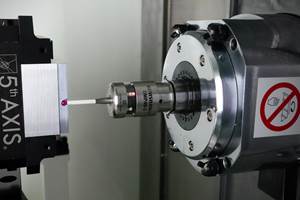20 Questions To Help Select The Right Gage And Master
You will soon be going into production with a new component. There are six or eight ways you could measure the part and dozens of products that might do the job.
You will soon be going into production with a new component. There are six or eight ways you could measure the part and dozens of products that might do the job. Instead of getting all stressed out about making the decision, let's look at your problem from a different perspective.
Twenty Questions is a game in which you try to discover the person, place or thing your opponent is thinking about by asking a series of questions that can be answered by ‘yes' or ‘no.' A good player uses the process of elimination to zoom in on the correct answer quickly. You can go about solving your gage selection dilemma in a similar way.
- What is the nature of the features to be inspected? Are they flat, round or otherwise; ID or OD; easily accessible or next to a shoulder, or inside a bore or a narrow groove?
- What level of accuracy are you looking for? A 10:1 ratio of gage resolution to tolerance is the popular rule of thumb.
- How much are you willing to pay for super accuracy? Before setting up a gaging operation for extremely close tolerance, verify that a high level of accuracy is really necessary.
- Will your gaging process be subject to a GR&R study, and if so, how will it be structured? If passing GR&R is one of your requirements, you should be prepared to discuss the details with your gage supplier.
- How important is gaging throughput? If a fixed gage will save 1,000 hours of labor over the course of a production run, it may pay for itself.
- How long is this job going to last? If the particular job has a short life, high throughput measurement may be too costly.
- How about flexibility? Sometimes it's appropriate to buy a gage based on overall shop requirements instead of one that measures a specific dimension with optimal efficiency.
- What do you intend to do with the reading once you get it? Will you need digital output?
- How important is ease of use? Especially for shopfloor gaging, you want to reduce the need for operator skill and the possibility of operator influence.
- Is your ideal gage one that can be maintained or thrown away? Gages that can be reset to a master to compensate for wear are generally more economical, but they may require frequent mastering.
- Is the part dirty or clean at the stage of processing in which you want to measure it? That may affect labor requirements, maintenance and the level of achievable accuracy, or it might steer you toward air gaging, which tends to be self-cleaning.
- Will the work environment be subject to vibration, dust or temperature changes?
- Would it be better to bring the gage to the part or vice versa?
- What happens to the part after it's measured? Are bad parts discarded or reworked? Is there a sorting requirement?This question may alert you to the potential of automated parts handling for efficiency.
- Is the part compressible? Is it easily scratched? Many standard gages can be modified to avoid such influences.
- Does the machine tool impose certain geometric and surface finish irregularities requiring measurement? If so, what is the nature of these deformations?
- What kind and grade of master do you need? They are graded as Z, Y, X, XX and XXX, with Z as the least accurate and and XXX being the most. The class you buy is determined by the ten-to-one rule in comparison to the gage.
- What about master materials? It will depend on your gaging environment. Steel is least expensive and is preferred where there is temperature cycling, because it expands and contracts in proportion to most parts. Chrome plating protects against corrosion. Carbide masters, which are the most expensive, are highly resistant to abrasion and corrosive chemicals. Unlike steel, however, they exhibit only a third of the thermal expansion and contraction.
- What's your budget? If you absolutely cannot come up with the funds for the gaging solution of your dreams, you'll have to go back over the questions to see where you can compromise.
What do you do when you've answered all the questions I gave you and you still don't know which gage is best? The answers you have written down to the first 19 questions are a good starting point for a meaningful discussion with your gaging supplier. Throw the ball in a supplier's court, and get some help.
Related Content
Determining Out-of-Roundness at the Point of Manufacture
George Schuetz, Mahr Inc.’s Director of Precision Gages, offers these techniques for measuring roundness on the shop floor.
Read MoreHow to Choose the Correct Measuring Tool for Any Application
There are many options to choose from when deciding on a dimensional measurement tool. Consider these application-based factors when selecting a measurement solution.
Read MoreHow To Calibrate Your Calipers
If you’re interested in calibrating your own digital, dial or Vernier calipers, here are some steps to take to make sure it goes off without a hitch.
Read MoreWhat Should Machinists Know About In-Machine Probing?
In-machine probing doesn’t reach the power of CMMs but can still be useful for pre- and mid-process control, as well as for “rough screening” of parts.
Read MoreRead Next
3 Mistakes That Cause CNC Programs to Fail
Despite enhancements to manufacturing technology, there are still issues today that can cause programs to fail. These failures can cause lost time, scrapped parts, damaged machines and even injured operators.
Read MoreThe Cut Scene: The Finer Details of Large-Format Machining
Small details and features can have an outsized impact on large parts, such as Barbco’s collapsible utility drill head.
Read More









.png;maxWidth=300;quality=90)













